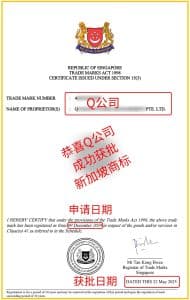Same Trademark, Different Applicant—Drastically Different Outcomes?
When registering a trademark in Singapore, should it be under an individual or a company name? Many entrepreneurs initially focus solely on “who can submit faster and more conveniently,” overlooking the long-term implications for asset ownership, financing valuation, litigation liability, business continuity, and cross-border expansion.
More critically, many confuse ACRA’s “Company/Business Name Registration” with trademark protection, or mistakenly believe that passing a company name verification grants exclusive rights. Only when scaling up do they discover their trademark has been squatted by others or revoked for “non-use.”
ACRA explicitly warns: Company name registration does not automatically confer any trademark rights. To obtain exclusive rights, a separate trademark application must be filed with IPOS.

Source: IPOS, Lianhe Zaobao

I. System Positioning and Common Misconceptions:
ACRA ≠ IPOS, Name ≠ Trademark Rights
1. Two Systems, Two Sets of Rights
ACRA oversees business entities and names (BizFile+). Name approval only permits you to register a company or business name using that designation; it does not grant trademark rights to the name. ACRA’s website clearly states: “Registering a company name is not equivalent to registering a trademark. To secure exclusive rights, apply separately to IPOS.”
IPOS manages trademark registration, maintenance, and disputes (IPOS Digital Hub/e-Trademark). You must file applications by goods/services classification. Registration becomes effective after examination approval and unopposed publication, offering 10-year protection renewable upon expiration.
Singapore trademark applications typically take 9–12 months to approve. With complete documentation, approval can be expedited to 6 months—we recently secured an IPOS approval letter for a client in just over 5 months. Contact your account manager for trademark application assistance.

Fig: Q Company successfully registers Singapore trademark. Unauthorized use of this image is strictly prohibited!
2. Who Can Apply?
Under Singapore law, “any person claiming to be the proprietor of a trademark” may apply. This includes both natural persons (individuals) and legal persons (companies).
All applications, amendments, and subsequent management are processed through IPOS’s online system (e.g., use CM2 for owner information changes; CM4 for corrections; transfers/assignments follow relevant guidelines).
3. Registration Process & Timeline (Key Points)
Search & assess registrability → Submit application (multiple classes allowed) → Formal & substantive examination → Publication period (third parties may file oppositions) → Registration granted, certificate issued. Official pathways and online services are available on IPOS pages such as “How to Register” and “Digital Hub”.
4. Frequent Trigger: “Non-Use Cancellation”
Registration is not the end. If a trademark remains unused in Singapore for five consecutive years after registration, anyone may petition IPOS for cancellation (non-use grounds). This represents the most overlooked compliance red line for cross-border brands.
5. Publication and Disputes Are Not Uncommon
Media reports indicate IP system activity: high trademark application volumes, frequent oppositions and disputes; IPOS has introduced tools like IPOS Go to reduce front-end processing times and encourages swift resolution of trademark disputes through mediation. This confirms the existence and prevalence of the “snap-up—opposition—mediation” chain.
*Business/trade name registration and trademark registration are separate processes: Trademarks renew every 10 years and can be revoked for non-use after 5 years; disputes are commonplace. Understanding these “systemic dynamics” is essential before selecting the appropriate entity.

Source: Lianhe Zaobao

II. Entity Selection Breakdown:
Individual vs. Company: Advantages, Disadvantages, and Suitable Scenarios
1. Registration in Individual Name
① Advantages
Greater flexibility in decision-making and disposal: Authorization, transfer, and licensing are determined solely by the individual, suitable for personal IP (designers, illustrators, streamers, bloggers, handmade brands).
Strong stability tied to personal identity: Unaffected by corporate restructuring (mergers, name changes, equity transfers).
Low startup costs and simplified processes: More accessible for early-stage creators/side hustlers.
② Disadvantages
Weak risk isolation: Personal assets liable for infringement disputes or contractual obligations, lacking corporate “limited liability” protection.
Limited commercialization and financing: When seeking investment/mergers/brand valuation, investors often require trademark transfer to the company. Failure to do so may slow transactions due to “mismatch between brand and operating entity.”
Collaboration risks: When multiple parties operate under an individual trademark without written ownership/licensing agreements, disputes easily arise upon dissolution.
③ Suitable Scenarios
Asset-light “personal brand” models centered on creators/consultants/independent e-commerce operators;
High demand for short-term flexibility, with no immediate pursuit of scaling or external capital.

Source: IPOS
2. Registration in the Company’s Name
① Advantages
Assetization and valuation-friendly: Trademarks can be recorded as corporate intangible assets, facilitating financing, M&A, and external licensing.
Stronger risk isolation: Disputes fall under the company’s limited liability scope, safeguarding shareholders’ personal assets.
Standardized governance: Licensing/authorization/disposal requires corporate decision-making processes, protecting all shareholders’ interests; facilitates expansion through franchising, joint ventures, or regional agencies.
② Disadvantages
Higher governance costs and procedures: Post-company name changes, address updates, or organizational restructuring, trademark registration details must be synchronized to avoid procedural risks.
Entity Continuity Risks: If a company undergoes dissolution/liquidation without properly handling trademarks (transfer, licensing, renewal, file migration), reactivation may encounter rights gaps or disputes.
Initial Setup Slightly Heavier Than Individual: Requires application and management using corporate documentation.
③ Applicable Scenarios
Businesses requiring scaled operations, franchise licensing, investment attraction, or M&A—such as chain restaurants, FMCG, e-commerce, and tech products;
Businesses planning to establish Singapore as a brand hub for expansion into ASEAN or global markets (via Madrid System extensions).
④ Alignment with Key Regulatory Requirements
Regardless of whether the holder is an individual or a company, changes to rights holder information must be submitted to IPOS via designated forms (e.g., CM2/CM4). Transfers/licenses must also be processed and recorded according to IPOS guidelines to ensure chain integrity and enforceability.

Source: Lianhe Zaobao

III. Hidden Pitfalls Checklist:
Overlooked Details and Their Costs
Pitfall 1: Confusing “Company Name Approval/Trade Name Registration” with “Trademark Rights”
ACRA explicitly states: These are not the same. Many teams secure a “great name” during initial setup, launch their website and social media, only to discover during platform brand registration/fundraising/overseas registration that without a trademark certificate, nothing can proceed.
Pitfall 2: Assuming “Registration Means All Is Well,” Neglecting “Actual Use” and Evidence Preservation
If the trademark isn’t genuinely and continuously used in Singapore for the designated goods/services within five years of registration (with verifiable evidence chains like invoices, advertisements, listings, contracts, or licenses), any third party can petition for revocation on grounds of “non-use.” Many dormant trademarks face targeted challenges precisely when the brand gains traction.
Pitfall 3: Lax Renewal and Status Management
Trademarks expire after 10 years and require renewal. While a 6-month “grace period” allows for costly remedies after expiration, further delay results in a ‘Removed’ status (recoverable). Failure to act within the subsequent “final 6-month” window effectively declares the trademark “dead.” Many startups change legal counsel or agents, leaving renewal emails unanswered—missing this window carries severe consequences.
Pitfall 4: Disconnect Between Ownership and Operations
• Trademarks registered under an individual are operated by a company;
• A parent company holds trademarks while subsidiaries sign external contracts;
• Franchise systems lack proper licensing filings and usage protocols.
Compliance reviews, external licensing, platform registrations, or infringement lawsuits will expose these ownership mismatches, undermining external claims or valuation negotiations.
Pitfall 5: Failure to Update Trademarks After Corporate Changes/Relocations/Renaming
Outdated trademark records create procedural hurdles for future licensing filings, enforcement complaints, renewals, or transfers. While IPOS provides amendment forms (e.g., CM2/CM4) and an “Application Management” portal, many teams lack an “IP Management Ledger,” making retroactive fixes time-consuming and costly.
Pitfall 6: Failure to address trademarks before company liquidation/dissolution
Common among teams experiencing “Startup 1.0 failure followed by 2.0 revival”: The company dissolved, but trademarks weren’t transferred. Years later, when attempting to revive the old brand, they face a triple blow: revocation, squatting by others, or broken evidence chains. Instead of chasing solutions afterward, complete transfer and licensing arrangements before dissolution.
Pitfall 7: Lack of Internal Written Agreements
Early-stage partnerships rely on “verbal agreements,” leaving trademarks registered under one individual’s name. When investors join, they discover unclear ownership rights. The correct approach is to specify in articles of association or shareholder agreements: trademark ownership, transfer options, licensing plans, valuation, and consideration—resolving uncertainties upfront.
Supporting Evidence: Frequent Disputes
Media reports indicate high trademark application volumes and numerous objections. Concurrently, IPOS mediation channels are increasingly utilized for expedited resolutions. This underscores the complexity of trademark ownership and management—never underestimate it.

Source: IPOS

IV. Practical Decision-Making Methodology:
Five-Dimensional Decision-Making + Two Strategic Approaches
1. Five-Dimensional “Checklist” to Determine Ownership Structure
Dimension 1: Development Path
Individual IP-Driven (Creators, Consultants, Streamers): Prioritize individual registration for flexibility and efficiency;
Corporate/Chain/International Expansion: Prioritize corporate registration for valuation and licensing network advantages.
Dimension 2: Risk Tolerance
Low-dispute, asset-light ventures: Individuals can handle;
High-competition/high-licensing frequency (food service, e-commerce, FMCG, SaaS): Companies provide stronger “shielding.”
Dimension 3: Capitalization Needs
Future plans for financing/M&A/equity incentives? Company-held trademarks are more suitable.
Individual acquisition followed by swift transfer to a company is possible, but tax implications and consideration arrangements must be considered.
Dimension 4: Operational Structure
Plans for franchising/agency/joint ventures? Corporate ownership facilitates centralized licensing and standardized protocols.
For international expansion (Madrid System): Using Singapore as the home country aligns better with multinational compliance and due diligence logic when held by a company.
Dimension 5: Compliance Capability
Does the team possess “IP management capabilities” for renewals, usage evidence retention, and registration amendments?
If not, prioritize the standard approach of “corporate ownership + standardized licensing” for easier recognition by investment banks, law firms, and platforms.

Source: IPOS
2. Two “Combination Strategies” for Different Stages
Strategy ① “Individual Launch—Rapid Protection—Window Transfer”
Suitable for personal brands or ultra-early-stage projects:
The individual first applies for core categories to secure positions;
After business validation/company incorporation, transfer the trademark to the company via written agreement with consideration (or retain individual ownership while granting exclusive license to the company and completing filing);
Post-transfer/licensing, promptly file with IPOS and update records to ensure enforceability externally;
Maintain usage evidence to prevent revocation for non-use within 5 years.
Strategy ② “Corporate Ownership—Operational Separation—Centralized Licensing”
Suitable for teams aiming for scale, cross-regional expansion, or franchising:
A holding company centrally owns trademarks, while operating entities (regional subsidiaries) obtain licenses;
During investment recruitment, platform onboarding, or due diligence, a single trademark asset list clarifies ownership, licensing, and usage scope;
When renaming/relocating/changing directors, synchronize IPOS updates (e.g., CM2/CM4);
Establish internal SOPs: renewal calendars, announcement monitoring, infringement reporting & evidence preservation.
3. Implementation Checklist
Step 1: Search & Naming
Follow ACRA’s name verification logic first, but don’t conflate name approval with trademark registration; conduct similarity searches (text/graphic) on IPOS to assess conflict probability.
Step 2: Define Classes
Prioritize core business classes first, then expand gradually based on business map to avoid overly broad coverage that invites scrutiny or excessive costs.
Step 3: Determine Entity
Select individual/corporate based on “five-dimensional assessment” results; use transitional approach (individual registration—corporate transfer) if uncertain.
Step 4: Documentation & Renewal
Create an “Evidence Folder”: invoices, ad screenshots, contracts, listing pages, authorization letters. Set renewal reminders, embedding the 10-year cycle and “6+6-month window” into your company compliance calendar.
Step 5: Continuous Monitoring & Rapid Dispute Resolution
Monitor opposition notices during the announcement period and market infringement signals. When necessary, pursue mediation channels for swift resolution to save time and costs.

Source: IPOS
Conclusion: Transform a Single “Choice” into Long-Term “Success Rate”
The core question of choosing between an individual or a company isn’t “which is more convenient,” but which better aligns with your business path.
For personal IP/light consulting/small-scale operations: Individual registration offers flexibility and efficiency.
For chain operations/platforms/international expansion: Company registration provides greater risk resilience, facilitates financing, and simplifies licensing.
Regardless of your path, engrave these three points into your team’s operational manual:
Name ≠ Trademark: ACRA and IPOS have distinct roles—never confuse them.
Registration ≠ Insurance: Unused for 5 years risks revocation; renewals required every 10 years—keep proof.
Ownership ≠ Verbal Agreements: Use written contracts, filings, and compliance ledgers to ensure “legally enforceable externally and transferable internally.”
Singapore’s trademark system is highly efficient and internationalized. Media reports frequently highlight IPOS’s advancements in digitalization, mediation, and global integration—bringing convenience while intensifying competition and demanding greater professionalism.
Get this choice right, and your trademark becomes more than a certificate: it transforms into “hard currency” for corporate valuation and cross-border growth.
Note: References sourced from IPOS Singapore, ACRA, Lianhe Zaobao, and compiled news reports. Reproduction requires attribution; contact for removal if infringing….
